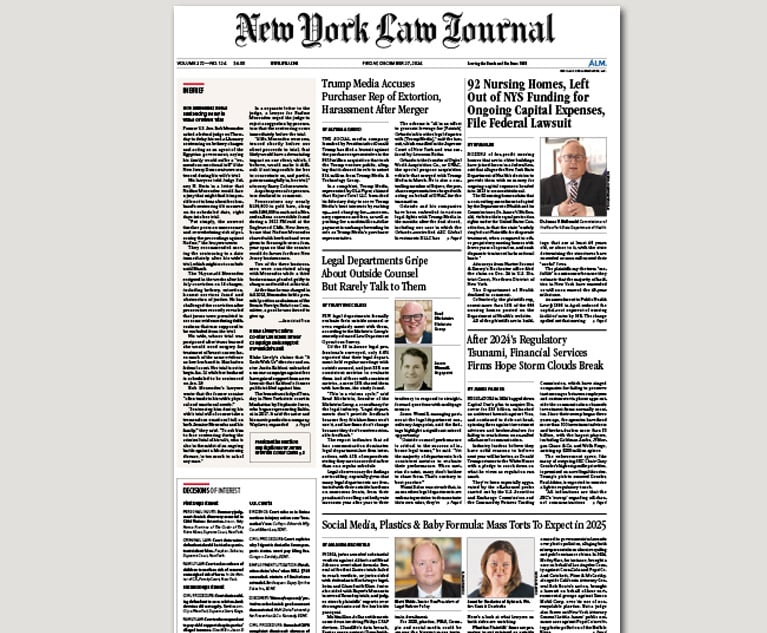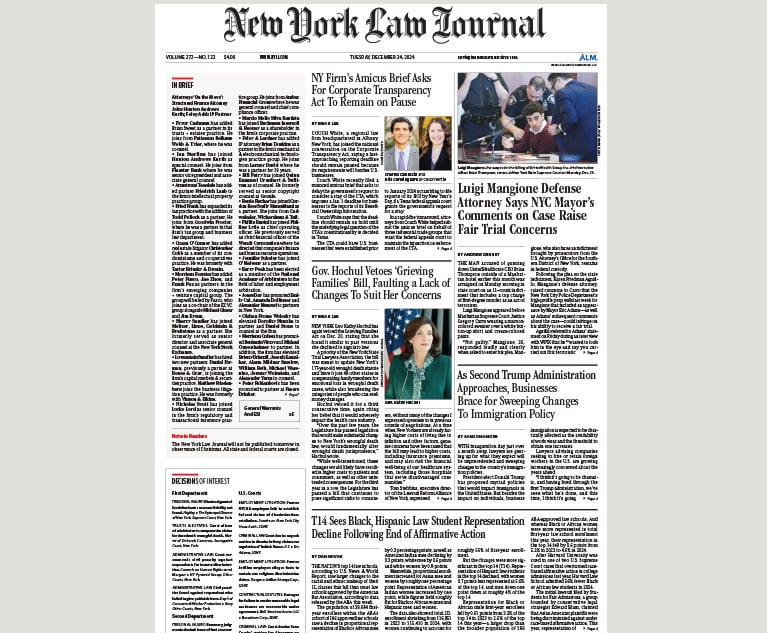 Michael B. Gerrard and Edward McTiernan
Michael B. Gerrard and Edward McTiernanSurvey of 2019 Cases Under State Environmental Quality Review Act
In their Environmental Law column, Michael B. Gerrard and Edward McTiernan look at six SEQRA cases in which the plaintiffs prevailed, but where the defendant government agencies might have survived judicial review had they been more careful in the preparation of their submissions.
July 08, 2020 at 12:15 PM
10 minute read
The courts decided 44 cases under New York's State Environmental Quality Review Act (SEQRA) in 2019. In only six did the courts overturn governmental decisions based on violations of SEQRA. Those six hold important lessons for litigants and project participants.
Eleven of the cases in this annual survey involved the preparation of an environmental impact statement (EIS); only one of those was overturned. There were 29 cases with no EIS; either a formal "negative declaration" had been issued, or the action was deemed Type II—that is, not requiring SEQRA review at all. Five of these case found agency action were contrary to law, or at least required further adjudication. The remaining cases cannot be classified in this manner. All the cases will be included in the 2020 update to our treatise on SEQRA.
The New York State Department of Environmental Conservation (DEC) also issued useful guidance. It released an updated version of its Program Policy on Assessing and Mitigating Visual and Aesthetic Impacts, and a fourth edition of its SEQR Handbook.
|Inwood case
The case where an EIS was prepared but the approvals were nonetheless annulled was Northern Manhattan Is Not for Sale v. City of New York, 2019 N.Y. Misc. LEXIS 6755 (Sup.Ct. N.Y. Co. 2019). It concerned the rezoning of the Inwood community. At several points during the SEQRA process a local group called Unified Inwood submitted detailed comments on the socio-economic consequences of the proposed rezoning. The City considered some of the comments, but not all. For example, according to the court, the City did not consider the effect that the rezoning might have on the emergency response times of first responders. In its own defense, the City said that it was following the methodologies set forth in a publication of the Mayor's Office of Environmental Coordination, the CEQR Technical Manual, which does not require analysis of this particular impact.
The court said that the CEQR Technical Manual "is a guideline, not a rule or regulation," and that its text states that "the methodologies it provides generally are appropriate but that they 'are not required by [City Environmental Quality Review, New York City's implementation of SEQRA]' because some projects may 'require different or additional analyses.'" The court noted that the City did conduct a brief review of the issues raised by United Inwood in opposition to the lawsuit, and "the same could have been done" in the draft or final EIS. The court concluded that the City "admittedly failed to take a hard look at the relevant areas of concern identified by the public and thus, failed to provide a reasoned elaboration of the basis for its determination of each one," so the City has not fully complied with SEQRA. The court remanded the matter to the City for a study of the issues raised by United Inwood and not considered in the EIS. The City is appealing this decision to the Appellate Division, First Department.
Thus even a brief discussion in the EIS of the emergency response time issue might have avoided this problem. This is consistent with many other decisions under SEQRA and its federal counterpart, the National Environmental Policy Act—courts will rarely disagree with the substantive technical analyses contained in and EIS, but they can be unforgiving if an issue raised by the public is ignored entirely. Lack of explicit instructions in the CEQR Technical Manual or other guidance is not a complete shield.
The courts are not always unforgiving, however. Edgewater Apartments v. New York City Planning Commission, 177 A.D.3d 576 (1st Dep't 2019), concerned an application by the Hospital for Special Surgery to renew a special permit that had been granted back in 2008 to build a new hospital building. The City Planning Commission renewed the permit. Neighbors who opposed the project argued that a new public hearing was required because there had been "substantial changes," especially since eight new medical facilities had been built nearby in the ensuing decade, increasing traffic, noise and other impacts. The Appellate Division bowed to the Commission's expertise and found it had "rationally exercised" its discretion. Justice Peter Tom concurred in the judgment, but lamented that the purpose of SEQRA "would be better served if a new environmental impact study were made." He added, "This strikes me, and likely the public and, manifestly, local residents, as a sounder planning approach even if the legal analysis, grounded in the rationality rather than the wisdom of the determination, proceeds along a much narrower path."
|Procedural Violations
The five cases going against local decisions made without benefit of an EIS all involved procedural violations. In all five cases, pertinent information either was not gathered, or was not shared with relevant parties at the proper time, or was not explained.
Sierra Club v. Department of Parks & Recreation of the City of New York, 2019 N.Y. Misc. LEXIS 6940 (Sup.Ct. N.Y. Co. 2019), concerned proposed changes to Fort Greene Park in Brooklyn, including removal of trees, replacement of a grassy area with a concrete playground, and alteration of the park's entrance. The Parks Department declared this a Type II action not requiring further SEQRA review. It turned out that the Parks Department had retained an urban landscape architecture design firm whose 151-page report recommended retaining the lawn area, discussed the importance of retaining as many trees as possible, and otherwise had information that was inconsistent with a finding of no significant impact. However, the Parks Department did not annex or even mention the report. The court said it was "troubled" by the Department's failure to mention the report and its apparent disregard of the report in making its decisions. The court also found that the Department had failed to provide a reasoned elaboration of the reasons for its determination, which is a requirement of SEQRA.
In Greentree Foundation v. Mammina, 2019 NYLJ LEXIS 2139 (Sup.Ct. Nassau Co. 2019), the North Hempstead Board of Zoning Appeals granted the application of Northwell Health to build an addition to an existing hospital. After the Board held a public hearing on the matter, "it accepted and relied upon documents which were submitted after the public hearing and not provided to the petitioner." The court found it was improper for the Board to have relied on such post-hearing submissions, and "fairness requires that petitioner be given the opportunity to rebut such evidence." The court annulled the approval and remanded the matter to the Board "for proper consideration and determination, pursuant to a public hearing wherein petitioner is granted the proper opportunity to submit and rebut evidence upon which the board members can render a proper determination based upon the evidence."
General Municipal Law Section 239-m requires that certain planning decisions be submitted to the county planning agency for review. In Save Harrison v. Town/Village of Harrison, 168 A.D.3d 949 (2d Dept. 2019), the town amended its zoning code to allow construction of a 160-unit senior living facility, and prepared no EIS. The town referred the initial rezoning application and supporting documents to the Westchester County Planning Board. However, the applicant later submitted numerous environmental studies to the town, which were required by the town planning board to issue its negative declaration. The court found that the town was required to refer these documents to the County Planning Board, and failure to do so would be a violation of Section 239-m. But since the record was unclear regarding whether or not the documents had in fact been referred as required, this issue was left for later adjudication.
Missing documents or other information were also at the heart of Carr v. Village of Lake George Village Board, 64 Misc.3d 542 (Sup.Ct. Warren Co. 2019). James Quirk, who owns a tour boat company, applied for variances to build an indoor 12,000-foot boat storage facility on his property. He also planned to build an outdoor boat storage facility on a neighboring parcel he owns that houses a laundromat. A neighboring property owner, John Carr, sued the village. The Village Planning Board had found that SEQRA requires a review of the project as a whole—both the indoor and the outdoor boat storage facilities—and the court agreed. Otherwise this could amount to improper segmentation. However, the application did not contain sufficient information about the possibility of an outdoor facility. Without this information, "the Planning Board is dealing entirely in unknowns and cannot conduct a meaningful review." The court remanded the application for site plan approval to the Planning Board for further SEQRA review.
Finally, Frank J. Ludovico Sculpture Trail Corp. v. Town of Seneca Falls, 173 A.D.3d 1718 (4th Dept. 2019), was brought by the owner of a trail that is home to numerous sculptures inspired by the women's rights movement and created primarily by women sculptors. It is near the Women's Rights National Historical Park, which commemorates the First Women's Rights Convention of 1848, led by Elizabeth Cady Stanton. The town wanted to acquire by condemnation an easement along the trail in order to install a sewer line. DEC notified the town that its database indicated the presence of certain endangered, threatened or rare animal and plant species on the project site, in particular the northern long-eared bat, the imperial moth, and the northern bog violet (a plant). DEC recommended that the town conduct a survey and determine whether the project site contains habitats favorable to such species, so that protective measures could be taken. The town did not undertake this survey. It assumed the species were present, but did not require any actions to protect them other than saying that the bats would not be affected because tree clearing would occur in winter when the bats were hibernating in caves; for the other species, the town merely made "the bare conclusion that there would be no significant impact on those species."
The court found that the town had failed to take a hard look at the project's impact on wildlife and failed to make a reasoned elaboration of the basis for its determination. The town also failed to explain how it would avoid adverse impacts on a stream corridor. The court found that the negative declaration was arbitrary and capricious, and it annulled the town action acquiring the easement.
In all six of these cases where plaintiffs prevailed, the defendant government agencies might have survived judicial review had they been more careful in the preparation and distribution of their written submissions. This is a valuable lesson for all concerned.
Michael B. Gerrard is a professor and Faculty Director of the Sabin Center for Climate Change Law at Columbia Law School, and Senior Counsel to Arnold & Porter. Edward McTiernan is a partner in Arnold & Porter and a former General Counsel of the New York State Department of Environmental Conservation.
This content has been archived. It is available through our partners, LexisNexis® and Bloomberg Law.
To view this content, please continue to their sites.
Not a Lexis Subscriber?
Subscribe Now
Not a Bloomberg Law Subscriber?
Subscribe Now
NOT FOR REPRINT
© 2024 ALM Global, LLC, All Rights Reserved. Request academic re-use from www.copyright.com. All other uses, submit a request to [email protected]. For more information visit Asset & Logo Licensing.
You Might Like
View All
After 2024's Regulatory Tsunami, Financial Services Firms Hope Storm Clouds Break

Law Firms Mentioned
Trending Stories
- 1Wholesale Real Estate Transaction Transparency and Protection Act Takes Effect Jan. 4: What You Need to Know
- 2Decision of the Day: 'Attorney's Eyes Only' Protective Order Denied; Good Cause Not Demonstrated
- 3The Crypto Guys Seem to Like Paul Atkins as a New SEC Commissioner, but Will He Be Good for the Securities Industry?
- 4Lawsuits, AI Accuracy and Debt: Legal Tech Companies that Ran Into Trouble in 2024
- 5Preemptive Litigation: A Potential Approach for a Precise Situation
Who Got The Work
Michael G. Bongiorno, Andrew Scott Dulberg and Elizabeth E. Driscoll from Wilmer Cutler Pickering Hale and Dorr have stepped in to represent Symbotic Inc., an A.I.-enabled technology platform that focuses on increasing supply chain efficiency, and other defendants in a pending shareholder derivative lawsuit. The case, filed Oct. 2 in Massachusetts District Court by the Brown Law Firm on behalf of Stephen Austen, accuses certain officers and directors of misleading investors in regard to Symbotic's potential for margin growth by failing to disclose that the company was not equipped to timely deploy its systems or manage expenses through project delays. The case, assigned to U.S. District Judge Nathaniel M. Gorton, is 1:24-cv-12522, Austen v. Cohen et al.
Who Got The Work
Edmund Polubinski and Marie Killmond of Davis Polk & Wardwell have entered appearances for data platform software development company MongoDB and other defendants in a pending shareholder derivative lawsuit. The action, filed Oct. 7 in New York Southern District Court by the Brown Law Firm, accuses the company's directors and/or officers of falsely expressing confidence in the company’s restructuring of its sales incentive plan and downplaying the severity of decreases in its upfront commitments. The case is 1:24-cv-07594, Roy v. Ittycheria et al.
Who Got The Work
Amy O. Bruchs and Kurt F. Ellison of Michael Best & Friedrich have entered appearances for Epic Systems Corp. in a pending employment discrimination lawsuit. The suit was filed Sept. 7 in Wisconsin Western District Court by Levine Eisberner LLC and Siri & Glimstad on behalf of a project manager who claims that he was wrongfully terminated after applying for a religious exemption to the defendant's COVID-19 vaccine mandate. The case, assigned to U.S. Magistrate Judge Anita Marie Boor, is 3:24-cv-00630, Secker, Nathan v. Epic Systems Corporation.
Who Got The Work
David X. Sullivan, Thomas J. Finn and Gregory A. Hall from McCarter & English have entered appearances for Sunrun Installation Services in a pending civil rights lawsuit. The complaint was filed Sept. 4 in Connecticut District Court by attorney Robert M. Berke on behalf of former employee George Edward Steins, who was arrested and charged with employing an unregistered home improvement salesperson. The complaint alleges that had Sunrun informed the Connecticut Department of Consumer Protection that the plaintiff's employment had ended in 2017 and that he no longer held Sunrun's home improvement contractor license, he would not have been hit with charges, which were dismissed in May 2024. The case, assigned to U.S. District Judge Jeffrey A. Meyer, is 3:24-cv-01423, Steins v. Sunrun, Inc. et al.
Who Got The Work
Greenberg Traurig shareholder Joshua L. Raskin has entered an appearance for boohoo.com UK Ltd. in a pending patent infringement lawsuit. The suit, filed Sept. 3 in Texas Eastern District Court by Rozier Hardt McDonough on behalf of Alto Dynamics, asserts five patents related to an online shopping platform. The case, assigned to U.S. District Judge Rodney Gilstrap, is 2:24-cv-00719, Alto Dynamics, LLC v. boohoo.com UK Limited.
Featured Firms
Law Offices of Gary Martin Hays & Associates, P.C.
(470) 294-1674
Law Offices of Mark E. Salomone
(857) 444-6468
Smith & Hassler
(713) 739-1250








